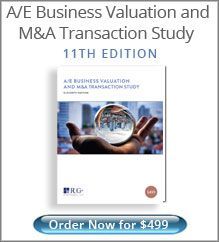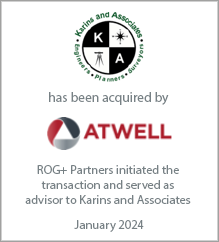With nearly fifteen years of corporate financial advisory experience, Jonathan Voelkel has worked with hundreds of engineering, architecture, and environmental consulting firms across the U.S. and abroad, in all facets of mergers & acquisitions, valuation, ownership transition planning, equity incentive compensation, and ESOP advisory. Jonathan received his Bachelor of Arts (BA) degree in Economics from Johns Hopkins University.
Unintended Consequences of Poor Financial Reporting
Unintended Consequences of Poor Financial Reporting
October 5, 2011
A client who called me to inquire about updating her firm’s valuation began our conversation by saying, “Not only are you going to be happy with our recent financial performance, you’re going to enjoy this engagement more than you have in the past!” Before I could express my curiosity (and perhaps more importantly, let her know I’ve always enjoyed working with her and her firm), she began singing the praises of the firm’s newly implemented accounting /project management software. Aha. Without prompting her to further explain her opening remark, I recalled our most recent project. Although highly profitable and seemingly well-organized, several cracks in her firm’s foundation had been exposed during the due diligence phase. At the time, given that many of her competitors were struggling to remain afloat, her firm remained buoyed by its high profit margins. After thoroughly working through the valuation process, we easily identified one key area that required immediate improvement: financial reporting.
Our scouring of spreadsheets and printouts a mile long revealed that while the firm’s financials were (thankfully!) prepared on a quasi-accrual basis, there was no way of easily discerning where labor dollars were being spent, what any of the non-interest “other expense” items were comprised of, or why there was no accounting for deferred tax liabilities (they’re a C-corp) – to mention only a few of the issues! The client, while briefly acknowledging the problem, countered by exclaiming, “But we’re still bucking the trend!” Nevertheless, I highlighted certain pitfalls that her firm would surely face if it continued to neglect putting forth a better effort in producing quality financial statements – she promised to look into my recommendations of software providers.
As it turns out, immediately after the engagement wrapped up, the firm made an investment in a suitable accounting/project management software suite, a decision that proved timely as revenues and profit were on the verge of a descent. During the implementation and training period, an open-book style of management was adopted and in the months following, all key managers of the business had the tools to make better decisions. Utilization, overhead rate, average collection period – these were just a few of the many metrics now trackable thanks in part to accountable financial reporting. Not completely out of the woods, yet, the firm also required debt financing at the time, the securing of which, in her words, “would have been a nightmare if we hadn’t gotten our numbers in order.”
Because most A/E firms aren’t capital-intensive, they have fewer reasons to enter into loan agreements than do firms that carry large fixed asset balances. As illustrated above, however, there is often a very real need to borrow money, and although professional service firms typically aren’t required to have a large ratio of assets-to-size, it isn’t uncommon to see them with some level of debt (various notes payable, non-compete covenants, acquisition funding, to name a few), or unreasonable to anticipate a day when borrowing will become a necessity for those who have never required it previously.
Creditors want a clear picture of the historical, current, and future cash flows and earnings of a company; the strength of the company’s asset base; and any outstanding loan agreements. The statements of income and cash flow are generally considered sufficient when gauging whether a creditor will be repaid, and the number most often focused on is EBITDA, because it highlights a company’s core profitability (by removing non-cash charges and non-operating expenses from earnings). Because of the insignificant amount of fixed assets carried by firms in our space, the two areas of a balance sheet that generally come under scrutiny are existing loan agreements and liquidity. Where a creditor will fall (senior or subordinate) to the borrower’s other debt, as well as the company’s short-term ability to meet its obligations and remain a viable entity are of particular interest to a creditor. Every bit of this type of data must be easily presentable and understandable to its intended users.
In the case of our client, the borrowed money helped get the firm through a difficult (albeit short) period, and because of improved financial reporting, the firm now has the ability to seek out areas that need greater focus before it’s too late; a benefit that might lessen the likelihood of a scramble to access capital in the future.
Banks aren’t the only external parties who rely on a company’s financial statements to make key decisions. In the stage of courtship when an acquirer gains access to a target firm’s financial statements, the quality of reporting can have a significant effect on how to further pursue the opportunity. At best, poorly presented financial statements can be a big headache for both sides, and can often lead a seller to incur additional costs related to providing satisfactory reporting. At worst, the integrity of an organization can be called into question when transparent statements aren’t available.
We recently advised a client on a potential acquisition candidate, which included providing an estimate on the fair market value of the target. Our analysis was based on less-than-ideal financial documentation, and when we requested supplementary data, were told that it wasn’t available. After discussing our findings with our client, a firm with deep M&A experience over the years not only through acquisitions, but also through divestitures, the response to our number was, “Let’s come in 25% below what we normally would’ve offered as a starting point.” I explained that our estimate of value (which was approximately 20% higher than what they intimated as their starting point) already took into account the risk associated with murky financials. The response? “We realize that. But without some sort of verification of their numbers, we don’t feel comfortable going anywhere near fair market value, given the implied risk.” Eventually, the deal broke down (due to an unrelated issue), but the lesson here had been learned – the absence of quality financial statements will do no one any favors.
There’s no good reason to engage in the practice of scant financial reporting. Preparing accurate and timely financial statements for internal AND external use should be a priority of any closely-held company’s finance/accounting team. Users of these statements should require accuracy and transparency to effectively assess financial and operational performance; poor reporting can lead to anything from a degradation of internal controls to missed opportunities for shareholders, managers, and their employees.
Constant communication of financial performance is critical to a company’s long-term success. While there isn’t a need to have financial statements audited (many of our clients don’t), they should be reviewed, or at a minimum, compiled by a CPA annually. Internally, accounting/project management software is a must for firms who need to track performance from the project level to the overall firm level.
Our scouring of spreadsheets and printouts a mile long revealed that while the firm’s financials were (thankfully!) prepared on a quasi-accrual basis, there was no way of easily discerning where labor dollars were being spent, what any of the non-interest “other expense” items were comprised of, or why there was no accounting for deferred tax liabilities (they’re a C-corp) – to mention only a few of the issues! The client, while briefly acknowledging the problem, countered by exclaiming, “But we’re still bucking the trend!” Nevertheless, I highlighted certain pitfalls that her firm would surely face if it continued to neglect putting forth a better effort in producing quality financial statements – she promised to look into my recommendations of software providers.
As it turns out, immediately after the engagement wrapped up, the firm made an investment in a suitable accounting/project management software suite, a decision that proved timely as revenues and profit were on the verge of a descent. During the implementation and training period, an open-book style of management was adopted and in the months following, all key managers of the business had the tools to make better decisions. Utilization, overhead rate, average collection period – these were just a few of the many metrics now trackable thanks in part to accountable financial reporting. Not completely out of the woods, yet, the firm also required debt financing at the time, the securing of which, in her words, “would have been a nightmare if we hadn’t gotten our numbers in order.”
Because most A/E firms aren’t capital-intensive, they have fewer reasons to enter into loan agreements than do firms that carry large fixed asset balances. As illustrated above, however, there is often a very real need to borrow money, and although professional service firms typically aren’t required to have a large ratio of assets-to-size, it isn’t uncommon to see them with some level of debt (various notes payable, non-compete covenants, acquisition funding, to name a few), or unreasonable to anticipate a day when borrowing will become a necessity for those who have never required it previously.
Creditors want a clear picture of the historical, current, and future cash flows and earnings of a company; the strength of the company’s asset base; and any outstanding loan agreements. The statements of income and cash flow are generally considered sufficient when gauging whether a creditor will be repaid, and the number most often focused on is EBITDA, because it highlights a company’s core profitability (by removing non-cash charges and non-operating expenses from earnings). Because of the insignificant amount of fixed assets carried by firms in our space, the two areas of a balance sheet that generally come under scrutiny are existing loan agreements and liquidity. Where a creditor will fall (senior or subordinate) to the borrower’s other debt, as well as the company’s short-term ability to meet its obligations and remain a viable entity are of particular interest to a creditor. Every bit of this type of data must be easily presentable and understandable to its intended users.
In the case of our client, the borrowed money helped get the firm through a difficult (albeit short) period, and because of improved financial reporting, the firm now has the ability to seek out areas that need greater focus before it’s too late; a benefit that might lessen the likelihood of a scramble to access capital in the future.
Banks aren’t the only external parties who rely on a company’s financial statements to make key decisions. In the stage of courtship when an acquirer gains access to a target firm’s financial statements, the quality of reporting can have a significant effect on how to further pursue the opportunity. At best, poorly presented financial statements can be a big headache for both sides, and can often lead a seller to incur additional costs related to providing satisfactory reporting. At worst, the integrity of an organization can be called into question when transparent statements aren’t available.
We recently advised a client on a potential acquisition candidate, which included providing an estimate on the fair market value of the target. Our analysis was based on less-than-ideal financial documentation, and when we requested supplementary data, were told that it wasn’t available. After discussing our findings with our client, a firm with deep M&A experience over the years not only through acquisitions, but also through divestitures, the response to our number was, “Let’s come in 25% below what we normally would’ve offered as a starting point.” I explained that our estimate of value (which was approximately 20% higher than what they intimated as their starting point) already took into account the risk associated with murky financials. The response? “We realize that. But without some sort of verification of their numbers, we don’t feel comfortable going anywhere near fair market value, given the implied risk.” Eventually, the deal broke down (due to an unrelated issue), but the lesson here had been learned – the absence of quality financial statements will do no one any favors.
There’s no good reason to engage in the practice of scant financial reporting. Preparing accurate and timely financial statements for internal AND external use should be a priority of any closely-held company’s finance/accounting team. Users of these statements should require accuracy and transparency to effectively assess financial and operational performance; poor reporting can lead to anything from a degradation of internal controls to missed opportunities for shareholders, managers, and their employees.
Constant communication of financial performance is critical to a company’s long-term success. While there isn’t a need to have financial statements audited (many of our clients don’t), they should be reviewed, or at a minimum, compiled by a CPA annually. Internally, accounting/project management software is a must for firms who need to track performance from the project level to the overall firm level.
Latest Perspective
Perfecting the A/E Exit Strategy – Five Key Factors
An enormous A/E generation that kicked off their careers in the 1980s and subsequently started firms or became owners in the 1990s ...
© 2024
Rusk O'Brien Gido + Partners, LLC
Financial Experts for Architects, Engineers, and Environmental Consulting Firms









